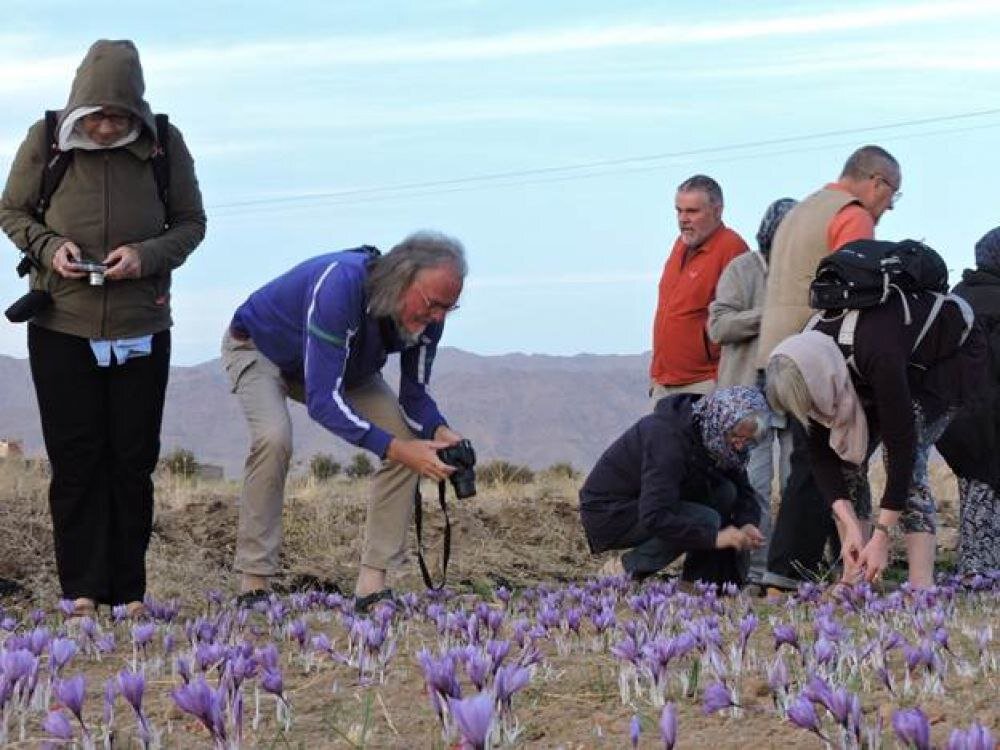Saffron harvest: a unique agritourism experience

TEHRAN – Saffron production in Iran is not not just an annual harvest; it’s a cultural celebration, a kind of feast, and an immersive journey into the heart of one of the world's most treasured spices.
Venturing into saffron fields during the harvest season, typically starting in early November, offers travelers an exclusive invitation to witness a mesmerizing process. As the sun gently rises, farmers clad in traditional attire delicately pluck each delicate saffron flower, a task passed down through generations. It's a picture that poartrays the painstaking effort and skill required to cultivate this precious spice.
The saffron harvest isn’t solely about collecting the delicate threads; it's a celebration of community, culture, and heritage. Traditional music fills the air, accompanied by laughter and jovial conversations among families and friends, creating an atmosphere brimming with warmth and hospitality.
Iran’s saffron, an emblematic agricultural product, boasts superior quality and is exported to a third of the world's nations, earning it titles like the “flower of health,” “king of spices,” and “red gold.”
While saffron is synonymous with Persian cuisine, its significance transcends the culinary world. Local experts eagerly share tales of saffron's historical and medicinal uses, revealing its role in traditional remedies and its potency in enhancing well-being.
Highly prized in Persian cuisine for its distinctive aroma, color, and flavor, this “red gold” from Iran reaches 65 countries, as highlighted by the vice president of the Association of Saffron Producers and Exporters of South Khorasan, Ali Hosseini, according to a recent report by Mehr news agency.
With a heritage dating back over 3,000 years, Iran stands as the premier producer of the world's finest saffron. Torbat-e Heydariyeh in Khorasan Razavi province is often referred to as the global capital of saffron production.
Apart from Khorasan Razavi, North Khorasan, and South Khorasan provinces, which serve as the primary hubs for saffron cultivation, regions like Chaharmahal-Bakhtiari and Khuzestan also participate in its production.
Renowned Iranian physicians such as Zakaria Raazi, Abu Ali Sina, and Abu Reyhan Birooni utilized saffron for medicinal purposes, a tradition that has endured for centuries.
Since 2016, a Saffron Farming System based on Qanat irrigation in Gonabad County has gained recognition from the FAO GIAHS Initiative as a Globally Important Agricultural Heritage System. This system utilizes indigenous knowledge and skills, passed down through generations, allowing local farmers to produce high-value saffron through the Qanat underground aqueduct.
The Saffron Farming System, reliant on Qanat irrigation, plays a pivotal role in generating employment, curbing migration, fostering sustainable livelihoods, enhancing water efficiency, and preserving indigenous knowledge for a sustainable future.
This international recognition by UNESCO and the FAO has drawn increasing numbers of eco-tourists to explore the region, including the Qanat System of Gonabad and the picturesque saffron fields, enriching the local economy while safeguarding the natural landscape.
Saffron holds a revered place in Persian culture, influencing aromatic dishes, vibrant desserts, and both physical and spiritual medicine.
The saffron harvest season, commencing in early November, offers a golden opportunity for agritourism, adorning the arid Iranian landscape with bright purple flowers amidst the absence of other vegetation.
Its ability to thrive with minimal water consumption enables saffron cultivation across diverse regions.
This precious herb, besides its culinary uses, finds application in the medical industry, exhibiting preventive properties against ailments like Alzheimer's and Parkinson's diseases, and offering treatment for various conditions, including colds, hepatitis, diabetes, and digestive issues.
Furthermore, saffron detoxifies the liver and kidneys, purifies the blood, aids in wound healing, and serves as a potent antioxidant, rich in vitamins B1, B2, B6, and C. Its antidepressant properties are associated with serotonin metabolism, mitigating symptoms of depression, anxiety, and other mental disorders.
Additionally, saffron serves as a natural permitted colorant in the food industry, a tradition dating back centuries in Iran, where saffron has been used in celebratory sweets and dishes.
Iran's saffron exports witnessed a notable surge of 52 percent in the initial five months of the current Iranian calendar year compared to the previous year, marking an increased value of about $88 million.
The top five destinations for Iranian saffron in this period included China, the UAE, Spain, Qatar, and Afghanistan, with exports reaching 47 different countries.
Notably, the saffron festival in Rafsanjan county and the saffron-related museum in Seno village, Gonabad, highlight the cultural significance and allure of this precious spice within Iran.
Beyond the fields, the saffron harvest opens doors to explore the rich cultural tapestry of Iran. Travelers can visit nearby villages, each with its unique charm, offering glimpses into local life, handicrafts, and ancient traditions.
AFM
Leave a Comment